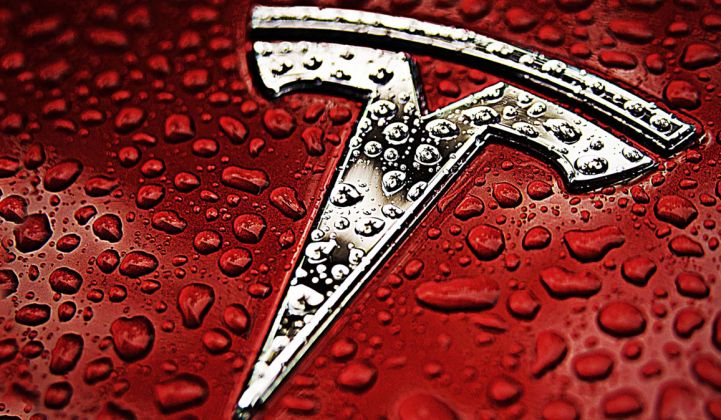Tomorrow, after the bell, Tesla will reveal the details of its fourth-quarter financials — and possibly provide some visibility into deliveries for this quarter. We should get the details of revenue, margins, profits (if any) and cash flow at a make-or-break juncture for the industry-disrupting electric-vehicle builder.
In August, Tesla CEO Elon Musk said, “I really want to emphasize that our goal is to be profitable and cash-flow positive for every quarter going forward.”
But this month, when Musk announced (in the sixth paragraph of an email) that Tesla would be reducing its workforce by 7 percent, he also wrote that last quarter’s $311 million in profit “was in part the result of preferentially selling higher-priced Model 3 variants in North America.”
He added, “This quarter, as with Q3, shipment of higher-priced Model 3 variants (this time to Europe and Asia) will hopefully allow us, with great difficulty, effort and some luck, to target a tiny profit.”
So margins and profits will likely fall despite rising revenue.
What to look for in this earnings call
During the earnings call, Tesla and its lightning-rod CEO are likely to confront a number of important issues.
Capital requirements: Including the impact of the $920M convertible bond maturing on March 1, the Shanghai factory, Model Y crossover development, and the ramp of the Solar Roof, the Semi truck, the new Tesla Roadster, and the pickup. Also on the to-do list is a refresh for the Model S and Model X.
The charger network will need to be built out to accommodate the volumes of EVs rolling off of Tesla’s lines. And service centers and parts inventory will have to scale with the brand’s growth as well.
Model 3 demand: Tesla pulled out all the stops to deliver a record 90,700 cars last quarter. But the first quarter of 2019 could suffer from the hangover of that delivery pull-in. Tesla has begun its Model 3 delivery efforts in Europe and China, but faces the headwinds of transport, homologation, new distribution networks, and tariffs. How many Model 3s were delivered in January?
According to the thesis of the short-seller community, U.S. Model 3 backlog was exhausted in the fourth quarter. Q4 2018 will serve as the peak for Tesla revenues, deliveries and GAAP profit, according to many of the shorts, and Q1 2019 will be a disappointment.
Model Y schedule: In October of last year, Musk claimed "significant progress" on the Model Y, Tesla's crossover. The CEO said that he "approved the prototype to go into production" and expects it to be in volume production in 2020. Tesla is expected to unveil the Model Y in the first half, or maybe even the first quarter, of this year.
S and X demand: Sales growth is flat, with roughly 100,000 units of the two models combined sold per year. What is the future of these luxury models?
Tesla made workforce cuts to the production teams of its luxury Model S and X vehicles, according to CNBC, which reports that the EV builder has also halted late-shift production of those models at the Fremont factory.
Other important matters: Musk might want to address the status of Full Self Driving, the reality of an affordable $35,000 Model 3 (when production cost is approximately $40,000), and the utilization and fate of the Buffalo plant.
Paying for all this capex
Morgan Stanley analysts expect a multibillion-dollar capital raise, despite Musk's difficult-to-explain determination not to go this route.
Low-interest loans from China might finance the factory; billions in deposits for the Model 3 and Model Y in China and Europe could finance Model Y development; and the actual corporate profits that Musk expects on a quarterly basis from here on in will also contribute to Tesla’s growth.
There are also asset-backed securities. Late last year, Tesla issued $837 million in its second issuance of securities backed by Tesla auto leases, according to Auto Finance News.
Stay tuned for existential outcomes
Tesla and Elon Musk have developed a pioneering and dominant position in the nascent American EV market and the European luxury auto market.
According to Automotive News, the Model S outsold the range-topping sedans from Mercedes, BMW and Audi in their European home markets in the first 10 months of 2018. Tesla owns almost half of the U.S. plug-in EV market, and a decent portion of global revenue for plug-in EVs, according to Inside EVs.
And Tesla is not limited to EV market dominance — the firm has a marked technical advantage as well.
Sandy Munro’s auto engineering consultancy performed a breakdown and analysis of Tesla's Model 3 last year. In an interview published on industry website Autoline Daily, Munro found that while Tesla has a “really heavy, expensive” body in white (an industry term for the basic sheet-metal structure of the car), he raved about the other systems, saying that its electronics, wiring harnesses, suspension, cooling and battery vastly outperform the industry’s status quo.
But Tesla can’t rest on these achievements — executing on production, cost, quality and demand creation are the existential issues facing the company this and next quarter.
As Musk said, the company needs "to continue making progress toward lower-priced variants of Model 3.”
That’s the variant with a few hundred thousand customer deposits.
Bloomberg's Tesla tracker shows Model 3 production levels at a trailing 13-week average of 5,280 cars per week, while logging a recent week with more than 6,000 units built.
We’ll report on this crucial call after the bell on Wednesday afternoon.




